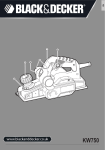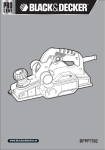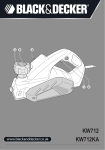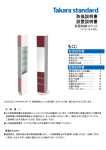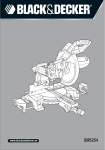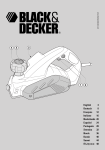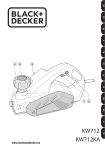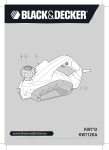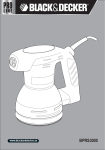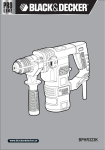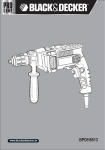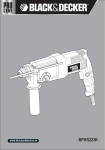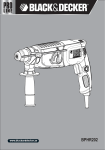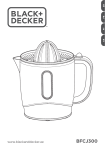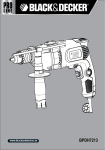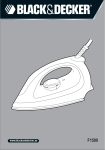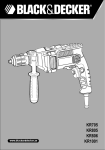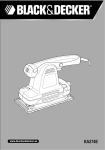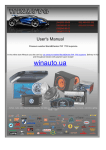Download Anglaise - Arabe - Service Client
Transcript
www.blackanddecker.ae
KW750
ENGLISH
1
3
5
6
2
4
2
ENGLISH
8
7
5
6
A
9
B
11
C
3
D
10
12
13
4
3
E
14
F
3
ENGLISH
21
20
P
G
H
17
19
18
16
15
I
4
J
22
ENGLISH
Intended use
Your Black & Decker planer has been designed
for planing wood, wood products and plastics.
The tool is intended for hand-held use. This tool
is intended for consumer use only.
Safety instructions
General power tool safety warnings
b. Avoid body contact with earthed or grounded
surfaces such as pipes, radiators, ranges and
refrigerators. There is an increased risk of
electric shock if your body is earthed or
grounded.
c. Do not expose power tools to rain or wet
conditions. Water entering a power tool will
increase the risk of electric shock.
Warning! Read all safety warnings and
d. Do not abuse the cord. Never use the cord for
all instructions. Failure to follow the
carrying, pulling or unplugging the power tool.
warnings and instructions listed below may
Keep cord away from heat, oil, sharp edges
result in electric shock, fire and/or serious injury.
or moving parts. Damaged or entangled cords
Save all warnings and instructions for future
increase the risk of electric shock.
reference.
e. When operating a power tool outdoors, use
The term "power tool" in all of the warnings
an extension cord suitable for outdoor use.
listed below refers to your mains operated
Use of a cord suitable for outdoor use
(corded) power tool or battery operated
reduces the risk of electric shock.
(cordless) power tool.
f. If operating a power tool in a damp location is
1. Work area safety
unavoidable, use a residual current device
a. Keep work area clean and well lit. Cluttered
(RCD) protected supply. Use of an RCD
or dark areas invite accidents.
reduces the risk of electric shock.
b. Do not operate power tools in explosive
3. Personal safety
atmospheres, such as in the presence of
flammable liquids, gases or dust. Power
a. Stay alert, watch what you are doing and use
tools create sparks which may ignite the dust
common sense when operating a power tool.
or fumes.
Do not use a power tool while you are tired or
under the influence of drugs, alcohol or
c. Keep children and bystanders away while
medication.
A moment of inattention while
operating a power tool. Distractions can
operating
power
tools may result in serious
cause you to lose control.
personal injury.
2. Electrical safety
b. Use personal protective equipment. Always
a. Power tool plugs must match the outlet.
wear eye protection. Protective equipment
Never modify the plug in any way. Do not use
such as dust mask, non-skid safety shoes,
any adapter plugs with earthed (grounded)
hard hat, or hearing protection used for
power tools. Unmodified plugs and matching
appropriate conditions will reduce personal
outlets will reduce risk of electric shock.
injuries.
5
ENGLISH
c. Prevent unintentional starting. Ensure the
c. Disconnect the plug from the power source
switch is in the off-position before connecting
and/or the battery pack from the power tool
to power source and/or battery pack, picking
before making any adjustments, changing
up or carrying the tool. Carrying power tools
accessories, or storing power tools. Such
preventive safety measures reduce the risk of
with your finger on the switch or energising
starting the power tool accidentally.
power tools that have the switch on invites
accidents.
d. Store idle power tools out of the reach of
children and do not allow persons unfamiliar
d. Remove any adjusting key or wrench before
with the power tool or these instructions to
turning the power tool on. A wrench or a key
operate the power tool. Power tools are
left attached to a rotating part of the power
dangerous in the hands of untrained users.
tool may result in personal injury.
e. Maintain power tools. Check for misalignment
e. Do not overreach. Keep proper footing and
or binding of moving parts, breakage of parts
balance at all times. This enables better
and any other condition that may affect the
control of the power tool in unexpected
power tools operation. If damaged, have the
situations.
power tool repaired before use. Many
accidents are caused by poorly maintained
f. Dress properly. Do not wear loose clothing or
power tools.
jewellery. Keep your hair, clothing and gloves
away from moving parts. Loose clothes,
jewellery or long hair can be caught in
moving parts.
g. If devices are provided for the connection of
dust extraction and collection facilities,
ensure these are connected and properly
used. Use of dust collection can reduce
dust-related hazards.
4. Power tool use and care
a. Do not force the power tool. Use the correct
power tool for your application. The correct
power tool will do the job better and safer at
the rate for which it was designed.
b. Do not use the power tool if the switch does
not turn it on and off. Any power tool that
cannot be controlled with the switch is
dangerous and must be repaired.
6
f. Keep cutting tools sharp and clean. Properly
maintained cutting tools with sharp cutting
edges are less likely to bind and are easier to
control.
g. Use the power tool, accessories and tool bits
etc., in accordance with these instructions,
taking into account the working conditions
and the work to be performed. Use of the
power tool for operations different from those
intended could result in a hazardous situation.
5. Service
a. Have your power tool serviced by a qualified
repair person using only identical
replacement parts. This will ensure that the
safety of the power tool is maintained.
Additional power tool safety
warnings
Warning! Additional safety warnings for
planers
ENGLISH
• Hold the power tool by insulated gripping
surfaces only, because the cutter may
contact its own cord. Cutting a "live" wire
may make exposed metal parts of the power
tool "live" and could give the operator an
electric shock.
• Use clamps or another practical way to
secure and support the workpiece to a
stable platform. Holding the work by your
hand or against the body leaves it unstable
and may lead to loss of control.
• Wait for the cutter to stop before setting the
tool down. An exposed rotating cutter may
engage the surface leading to possible loss
of control and serious injury.
• Keep the cutter sharp. Dull or damaged
cutters may cause the planer to swerve or
stall under pressure. Always use the
appropriate type of cutter for the power tool.
• Do not touch the workpiece or the cutter
immediately after operating the tool. They
can become very hot.
• Remove all nails and metal objects from the
workpiece before planning.
• Always hold the tool with both hands and by
the handles provided.
• Immediately disconnect the cable from the
mains if it is damaged or cut.
Warning! Contact with, or inhalation of dusts
arising from planing applications may endanger
the health of the operator and possible
bystanders. Wear a dust mask specifically
designed for protection against dust and fumes
and ensure that persons within or entering the
work area are also protected.
• This tool is not intended for use by persons
(including children) with reduced physical,
sensory or mental capabilities, or lack of
experience and knowledge, unless they have
been given supervision or instruction
concerning use of the appliance by a person
responsible for their safety. Children should
be supervised to ensure that they do not play
with the appliance.
• The intended use is described in this
instruction manual. The use of any accessory
or attachment or performance of any
operation with this tool other than those
recommended in this instruction manual may
present a risk of personal injury and/or
damage to property.
Safety of others
• This appliance is not intended for use by
persons (including children) with reduced
physical, sensory or mental capabilities, or
lack of experience and knowledge, unless
they have been given supervision or
instruction concerning use of the appliance
by a person responsible for their safety.
• Children should be supervised to ensure that
they do not play with the appliance.
Residual risks
Additional residual risks may arise when using
the tool which may not be included in the
enclosed safety warnings. These risks can arise
from misuse, prolonged use etc.
Even with the application of the relevant safety
regulations and the implementation of safety
devices, certain residual risks can not be
avoided. These include:
7
ENGLISH
• Injuries caused by touching any
rotating/moving parts.
• Injuries caused when changing any parts,
blades or accessories.
• Injuries caused by prolonged use of a tool.
When using any tool for prolonged periods
ensure you take regular breaks.
• Impairment of hearing.
• Health hazards caused by breathing dust
developed when using your tool (example:working with wood, especially oak, beech
and MDF.)
Vibration
The declared vibration emission values stated in
the technical data and the declaration of
conformity have been measured in accordance
with a standard test method provided by EN
60745 and may be used for comparing one tool
with another. The declared vibration emission
value may also be used in a preliminary
assessment of exposure.
Labels on tool
The following pictograms are shown on the tool:
Warning! To reduce the risk of injury,
the user must read the instruction
manual.
Electrical safety
This tool is double insulated; therefore
no earth wire is required. Always check
that the power supply corresponds to the voltage
on the rating plate.
• If the supply cord is damaged, it must be
replaced by the manufacturer or an
authorised Black & Decker Service Centre in
order to avoid a hazard.
Features
This tool includes some or all of the following
features.
1. On/off switch
2. Lock-off button
Warning! The vibration emission value during
actual use of the power tool can differ from the
declared value depending on the ways in which
the tool is used. The vibration level may
increase above the level stated.
3. Shavings discharge outlet
When assessing vibration exposure to
determine safety measures required by
2002/44/EC to protect persons regularly using
power tools in employment, an estimation of
vibration exposure should consider, the actual
conditions of use and the way the tool is used,
including taking account of all parts of the
operating cycle such as the times when the tool
is switched off and when it is running idle in
addition to the trigger time.
Assembly
8
4. Shavings discharge outlet selector
5. Planing depth adjustment knob
6. Planing depth graduation
Warning! Before assembly, make sure that the
tool is switched off and unplugged.
Replacing the cutting blades
(fig. A)
The cutting blades provided with this tool are
reversible. Replacement cutting blades can be
obtained from your local retailer.
ENGLISH
Removing
• Loosen the bolts (7) using the spanner
supplied.
• Slide the blade (8) out of the holder.
• Reverse the blade so that the unused side
comes in position. If both sides are worn, the
blade must be replaced.
Fitting
• Securely tighten the parallel fence adjustment
knob.
Note : The parallel fence should be below the
planer when installed correctly.
• To remove the parallel fence proceed in
reverse order.
Connecting a vacuum cleaner to
the tool (fig. D)
An adaptor is required to connect a vacuum
cleaner or dust extractor to the tool. The adaptor
against the end stop.
can be purchased from your local Black &
Tighten the bolts using the spanner supplied. Decker retailer.
• Slide the blade into the holder until it is
•
Warning! Always replace both cutters.
Adjusting the depth of cut
(fig. B)
The depth of cut is indicated by the marking (9).
The setting range can be read from the
graduation (6).
• Turn the planing depth adjustment knob (5)
to the required depth of cut.
• Slide the adaptor (12) over the shavings
discharge outlet (3).
• Connect the vacuum cleaner hose (13) to the
adaptor.
Fitting the shavings collection
bag (fig. E)
The shavings collection bag is particularly useful
when working in confined spaces.
• Turn the knob to the ‘P' postion whenever the • Slide the connecting plate (14) of the bag
tool is not in use.
Fitting and removing the
parallel fence (fig. C)
The parallel fence is used to for optimum control
on narrow workpieces.
• Thread the knob (11) into the hole on the
side of the planer and securely tighten.
• Loosen the parallel fence adjustment knob
(10).
• Slide the parallel fence into the desired
position.
over either side of the shavings discharge
outlet (3).
• To prevent chips from coming out opposite
side of shavings discharge outlet, move the
shavings discharge outlet selector (4) to the
opposite side from the bag.
Emptying the shavings
collection bag
The shavings collection bag should be emptied
regularly while using it to prevent blocking.
• Unzip the bag and empty it before continuing.
9
ENGLISH
Use
Parking rest (fig. H)
Warning! Let the tool work at its own pace. Do
not overload.
Your planer is equipped with a parking rest (21)
that automatically lowers into place when the tool
is lifted from the work surface. When planing, the
parking foot raises as the tool is pushed forward.
When the parking foot is lowered, the planer can
set on the work surface without the blade
touching.
• Adjust the depth of cut.
• If necessary, fit and adjust the parallel fence.
Switching on and off
Switching on
• Keep the lock-off button (2) depressed and
press the on/off switch (1).
• Release the lock-off button.
Switching off
• Release the on/off switch.
Planing
Hints for optimum use
• Move the tool along the grain of the wood.
• If the grain is cross or curly, or if the
workpiece material is a hard type of wood,
adjust the depth of cut to take only a very
thin shaving at each pass and take several
passes to achieve the desired result.
• Hold the tool with the nose piece of the shoe • To keep the tool in a straight line, press down
resting on top of the workpiece surface.
• Switch the tool on.
the front of the tool at the start, and press
down the back of the tool at the end of the
cutting stroke.
• Move the tool steadily forward to perform the Accessories
cutting stroke.
• Switch the tool off after the stroke has been
completed.
Rebating (fig. F)
• Fit and adjust the parallel fence.
• Proceed as for planing.
Chamfering edges (fig. G)
The V-groove in the nose piece of the shoe
enables you to chamfer edges at 45°, 30° and
15° angles.
• Hold the tool at an angle with the desired
groove (20) around the edge of the
workpiece and perform the cutting stroke.
10
The performance of your tool depends on the
accessory used. Black & Decker and Piranha
accessories are engineered to high quality
standards and designed to enhance the
performance of your tool. By using these
accessories you will get the very best from your
tool.
The following types of cutting blades can be
obtained from your local retailer:
- Tungsten carbide tipped reversible cutting
blades (part no. X35007, supplied per pair)
- High-speed steel reversible cutting blades
(part no. X24192-XJ11, supplied per pair)
ENGLISH
Maintenance
Mains Plug Replacement
Your tool has been designed to operate over a
long period of time with a minimum of
maintenance. Continuous satisfactory operation
depends upon proper tool care and regular
cleaning.
If a new mains plug needs to be fitted:
Warning! Before performing any maintenance,
switch off and unplug the tool.
• Connect the blue lead to the neutral terminal.
• Regularly clean the ventilation slots in your
green / yellow lead to the earth terminal.
tool using a soft brush or dry cloth.
• Regularly clean the motor housing using a
damp cloth. Do not use any abrasive or
solvent-based cleaner.
Replacing the drive belt (fig. I)
• Loosen the screws (15) and remove the
cover (16).
• Remove the old drive belt.
• Place the new belt (17) over the pulleys.
• Safely dispose of the old plug.
• Connect the brown lead to the live terminal of
the new plug.
• If the product is class l (earthed), connect the
Warning! If your product is class ll double
insulated (only 2 wires in the cord set), no
connection is to be made to the earth terminal.
Follow the fitting instructions supplied with good
quality plugs.
Any replacement fuse must be of the same
rating as the original fuse supplied with the
product.
Technical Data
Place the belt over the large pulley (18) first,
then over the small pulley (19), whilst
manually rotating the belt steadily.
• Put the cover back in place and tighten the
screws.
KW750
(Type 4)
Input voltage
Vac
220-240
Power input
W
750
Motor brush inspection and
replacement (fig. J)
No-load speed
min-1
16,500
Planing width
mm
82
Brushes should be regularly inspected for wear.
Planing depth
mm
2
• Remove brush cap (22). The brushes should
Rebating depth
mm
12
Weight
kg
2.9
slide freely in brush box. If brushes are worn
down to .3" (8mm) they should be replaced.
To reinstall, push new brush back into brush
box. If replacing existing brush, maintain same
orientation as when removed. Replace the
brush cap (do not overtighten).
11
ENGLISH
Protecting the environment
Warranty
Decker product needs replacement, or if it is of
If a Black & Decker product becomes defective
due to a material or manufacturing defect , within
12 months from the date of purchase, Black &
Decker guarantees to replace defective parts or
replace such products to ensure minimum
inconvenience to the customer unless:
no further use to you, do not dispose of it with
• The product has been subjected to misuse or
Separate collection. This product must not
be disposed of with normal household
waste.
Should you find one day that your Black &
other household waste. Make this product
available for separate collection.
• Black & Decker provides a facility for
recycling Black & Decker products once they
have reached the end of their working life.
This service is provided free of charge. To
take advantage of this service please return
your product to any authorised repair agent
who will collect them on our behalf.
• You can check the location of your nearest
authorised repair agent by contacting your
local Black & Decker office at the address
indicated in this manual. Alternatively, a list of
authorized Black & Decker repair agents and
full details of our after-sales service and
contact are available on the Internet at:
www.2helpU.com.
12
neglect.
• The product has sustained damage through
foreign objects, substances or accidents.
• Repairs have been attempted by persons
other than authorised repair agents or Black
& Decker service staff.
To claim on the warranty, you will need to submit
proof of purchase to the seller or an authorised
repair agent. You can check the location of your
nearest authorised repair agent by contacting
your local Black & Decker office at the address
indicated in this manual. Alternatively, a list of
authorised Black & Decker repair agents and full
details of our after-sales service and contacts are
available on the Internet at: www.2helpU.com.
Please visit our website www.blackanddecker.ae
to register your new Black & Decker product and
to be kept up to date on new products and
special offers. Further information on the Black &
Decker brand and our range of products is
available at www.blackanddecker.ae.
ARABIC
1
2
3
5
4
6
13
ARABIC
8
7
5
6
A
9
B
11
C
3
D
10
4
3
E
14
14
F
12
13
ARABIC
21
20
P
G
H
17
19
18
16
15
I
J
22
15
ARABIC
Ö«HÉfC’G πãe á°VQDƒŸG í£°SCÓd º°ù÷G á°ùeÓe ÖæŒ .Ü
ô£N OGOõj .äÉLÓãdGh óbGƒŸGh ICÉaóŸG Iõ¡LCGh
.É°VQD
k ƒe ∂ª°ùL ¿Éc GPEG á«FÉHô¡c áeó°üH ∂àHÉ°UEG
.áÑWôdG AGƒLC’G hCG ô£ª∏d á«FÉHô¡µdG Iõ¡LC’G ¢Vô©J ’ .ê
¤EG »FÉHô¡µdG RÉ¡÷G πNGO AÉŸG π∏îJ …ODƒj ±ƒ°S
.á«FÉHô¡c áeó°üH áHÉ°UE’G ô£N IOÉjR
ΩGóîà°S’G ¢VôZ
Ö°ûÿG §«£îàd ºª°üe ôµjO ófBG ∑ÓH §«£îàdG RÉ¡L
ºª°üe RÉ¡÷G Gòg .∂«à°SÓÑdGh á«Ñ°ûÿG äÉéàæŸGh
∂∏¡à°ùŸG ΩGóîà°S’ ºª°üe RÉ¡÷G Gòg .…hó«dG ΩGóîà°SÓd
.§≤a
áeÓ°ùdG äGOÉ°TQEG
á«FÉHô¡µdG Iõ¡LC’G áeÓ°S ¢Uƒ°üîH áeÉ©dG äGôjòëàdG
’ .»FÉHô¡µdG QÉ«àdG ∂∏°S ∫ɪ©à°SG IAÉ°SEG ΩóY »¨Ñæj .O
RÉ¡÷G πª◊ »FÉHô¡µdG QÉ«àdG ∂∏°S Ék≤∏£e Ωóîà°ùJ
áeÓ°ùdG äGôjò– áaÉc IAGôb »¨Ñæj !ôjò–
»¨Ñæj .QÉ«àdG øY ¬∏°üa hCG ¬Ñë°S hCG »FÉHô¡µdG
´ÉÑJG ΩóY ÖÑ°ùàj ób .äGOÉ°TQE’G áaÉch
hCG IQGô◊G øY Gók «©H »FÉHô¡µdG QÉ«àdG ∂∏°ùH ®ÉØàM’G
áeó°U çhóM ‘ »∏j ɪ«a IOQGƒdG äGOÉ°TQE’Gh äGôjòëàdG
.IÒ£N áHÉ°UEG hCG/h ≥jôM hCG/h á«FÉHô¡c
ójõJ .ácôëàŸG AGõLC’G hCG IOÉ◊G ±Gƒ◊G hCG âjõdG
áeó°üH áHÉ°UE’G ô£N øe áµHÉ°ûàŸG hCG áØdÉàdG ∑Ó°SC’G
´ƒLô∏d äGOÉ°TQE’Gh äGôjòëàdG áaɵH ®ÉØàM’G ≈Lôj
.á«FÉHô¡c
.kÓÑ≤à°ùe É¡«dEG
Ωóîà°SG ,≥∏£dG AGƒ¡dG ‘ »FÉHô¡µdG RÉ¡÷G 𫨰ûJ óæY .`g
.≥∏£dG AGƒ¡dG ‘ ΩGóîà°SÓd Ö°SÉæe π«°UƒJ ∂∏°S
‘ ΩGóîà°SÓd Ö°SÉæe »FÉHô¡c QÉ«J ∂∏°S ΩGóîà°SG
.á«FÉHô¡c áeó°üd ¢Vô©àdG ô£N øe π∏≤j ≥∏£dG AGƒ¡dG
‘ »FÉHô¡µdG RÉ¡÷G 𫨰ûJ ÖæŒ øµÁ ’ ¿Éc GPEG .h
øe ájÉbh RÉ¡L ΩGóîà°SG »¨Ñæj ¬fEÉa ,ÖWQ ¿Éµe
QÉ«àdG øe ájÉbƒdG RÉ¡L ΩGóîà°SG π∏≤j .»≤ÑàŸG QÉ«àdG
.á«FÉHô¡c áeó°üH áHÉ°UE’G ô£N øe »≤ÑàŸG
á«°üî°ûdG áeÓ°ùdG .3
º«∏°ùdG ¢ù◊G Ωóîà°SGh ¬∏©ØH Ωƒ≤J Ée ÖbGQh É k¶≤j øc .CG
Ωóîà°ùJ ’ .»FÉHô¡µdG RÉ¡÷G 𫨰ûàH Ωƒ≤J ÉeóæY
ÒKCÉJ â– hCG Ékµ¡æe ¿ƒµJ ÉeóæY »FÉHô¡µdG RÉ¡÷G
ÖÑ°ùàJ ób .AGhódG hCG á«dƒëµdG äÉHhöûŸG hCG ÒbÉ≤©dG
‘ á«FÉHô¡µdG Iõ¡LC’G 𫨰ûJ AÉæKCG á∏بdG øe á¶◊
.á¨dÉH á«°üî°T áHÉ°UEG çhóM
»bGh ÉehO
k …óJQG .á«°üî°ûdG ájÉbƒdG äGó©e Ωóîà°SG .Ü
πãe ájÉbƒdG äGó©e ΩGóîà°SG π∏≤j ±ƒ°S .Ú©dG
á©Ñ≤dGh ≥∏Mõà∏d á©fÉŸG ájòMC’Gh áHôJC’G äÉeɪc
äÉHÉ°UEG çhóM ô£N øe ™ª°ùdG »bGhh áÑ∏°üdG
.á«°üî°T
16
äGôjòëàdG áaÉc ‘ OQGƒdG "»FÉHô¡c RÉ¡L" í∏£°üŸG
πª©j …òdG »FÉHô¡µdG RÉ¡÷G ¤EG Ò°ûj √ÉfOCG IQƒcòŸG
…òdG »FÉHô¡µdG RÉ¡÷G hCG (É«k µ∏°S) »FÉHô¡µdG QÉ«àdÉH
.(É«k µ∏°S’) ájQÉ£ÑdÉH πª©j
πª©dG á≤£æe áeÓ°S .1
áØ«¶f ádÉM ‘ πª©dG á≤£æe ≈∏Y ®ÉØ◊G »¨Ñæj .CG
á¶àµŸGh áª∏¶ŸG ≥WÉæŸG ÖÑ°ùàJ .Gók «L IAÉ°†eh
.çOGƒM ´ƒbh ‘ ΩÉcôdÉH
AGƒLCG ‘ á«FÉHô¡µdG Iõ¡LC’G 𫨰ûàH º≤J ’ .Ü
á∏HÉb πFGƒ°S OƒLh ‘ É¡∏«¨°ûJ πãe ;ájQÉéØfG
èàæj á«FÉHô¡µdG Iõ¡LC’G .QÉÑZ hCG äGRÉZ hCG ∫É©à°TÓd
.áæNOC’G hCG QÉѨdG ∫É©°TEG ¤EG …ODƒJ ób äGQGöT É¡æY
RÉ¡÷G 𫨰ûJ AÉæKCG ÚLôØàŸGh ∫ÉØWC’G OÉ©HEG »¨Ñæj .ê
≈∏Y Iô£«°ù∏d ∂fGó≤a ‘ AÉ¡dE’G ÖÑ°ùàj ób .»FÉHô¡µdG
.RÉ¡÷G
á«FÉHô¡µdG áeÓ°ùdG .2
QÉ«àdG Qó°üe ™e »FÉHô¡µdG QÉ«àdG ¢ùHGƒb ≥aGƒJ Ωõ∏j .CG
,á≤jôW ájCÉH ¢ùHÉ≤dG πjó©J Ék≤∏£e ÖæŒ .»FÉHô¡µdG
.á°VQCÉŸG Iõ¡LC’G ™e ÅjÉ¡e ¢ùHGƒb ájCG Ωóîà°ùJ ’h
QÉ«àdG QOÉ°üeh ádó©ŸG ÒZ ¢ùHGƒ≤dG …ODƒJ ±ƒ°S
áeó°üd ¢Vô©àdG ô£N π«∏≤J ¤EG á≤aGƒàŸG »FÉHô¡µdG
.á«FÉHô¡c
ARABIC
QÉ«àdG Qó°üe øY »FÉHô¡µdG RÉ¡÷G ¢ùHÉb π°üaG .ê
ájCG AGôLEG πÑb ájQÉ£ÑdG áeõM øY hCG/h »FÉHô¡µdG
Iõ¡LC’G ‘ äÉ≤ë∏e ájCG Ö«côJ hCG äGÒ«¨J hCG äÓjó©J
á«FÉbƒdG áeÓ°ùdG äGAGôLEG π∏≤J .É¡æjõîJ hCG á«FÉHô¡µdG
¿hO ICÉéa »FÉHô¡µdG RÉ¡÷G 𫨰ûJ AóH ô£N øe √òg
.ó°üb
Gók «©H áeóîà°ùŸG ÒZ á«FÉHô¡µdG Iõ¡LC’G øjõîàH ºb .O
ÒZ ¢UÉî°TCÓd íª°ùJ ’h ∫ÉØWC’G ∫hÉæàe øY
ÒZ hCG »FÉHô¡µdG RÉ¡÷G ΩGóîà°SG ≈∏Y øjOÉà©ŸG
RÉ¡÷G 𫨰ûàH äGOÉ°TQE’G √òg ≈∏Y Ú©∏£ŸG
ÉeóæY Gô£N
k πµ°ûJ á«FÉHô¡µdG Iõ¡LC’G .»FÉHô¡µdG
.ÚHQóe ÒZ Úeóîà°ùe ój ‘ ¿ƒµJ
¿CG øe ócCÉJ .Oƒ°ü≤ŸG ÒZ 𫨰ûàdG AóH ™æe Ú©àj .ê
QÉ«àdG Qó°üà π«°UƒàdG πÑb ≥∏¨dG ™°Vh ‘ ìÉàØŸG
πªM hCG ™aQ hCG ájQÉ£ÑdG áeõëH hCG/h »FÉHô¡µdG
™HÉ°UC’Gh á«FÉHô¡µdG Iõ¡LC’G πªM …ODƒj .RÉ¡÷G
á«FÉHô¡µdG Iõ¡LC’G πªM hCG ,ìÉàØŸG ≈∏Y áYƒ°Vƒe
´ƒbh ¤EG ,𫨰ûàdG ™°Vh ‘ ¿ƒµJ »àdG ᣰûædG
.çOGƒM
πÑb …õ«∏‚EG ìÉàØe hCG …OÉY ìÉàØe …CG ádGREÉH ºb .O
ìÉàØŸG ∑ôJ ÖÑ°ùàj ób .»FÉHô¡µdG RÉ¡÷G 𫨰ûJ
çhóM ‘ »FÉHô¡µdG RÉ¡÷G øe QGhO AõéH Ék`≤∏©àe
.á«°üî°T áHÉ°UEG
RÉ¡÷G ¢üëaG .á«FÉHô¡µdG Iõ¡LC’G áfÉ«°U »¨Ñæj .`g
äÉÑK ≈∏Y ®ÉØ◊G »¨Ñæj .•ôØŸG ÜGÎb’G ΩóY »¨Ñæj .`g
ácôM ¥ƒ©J »àdG hCG áÑ«©ŸG AGõLC’G ≈∏Y ±ô©à∏d
øe ∂æµÁ Gòg .äÉbhC’G áaÉc ‘ ¿RGƒàdGh Úeó≤dG
AGõLC’G øe √ƒ∏N øe ócCÉà∏dh ácôëàŸG AGõLC’G
∞bGƒŸG ‘ »FÉHô¡µdG RÉ¡÷G ≈∏Y Ió«÷G Iô£«°ùdG
IAÉØc ≈∏Y ôKDƒJ ób iôNCG ádÉM …CG øeh IQƒ°ùµŸG
.á©bƒàŸG ÒZ
,∞∏J …CG ≈∏Y Qƒã©dG ” GPEG .á«FÉHô¡µdG Iõ¡LC’G 𫨰ûJ
èàæJ .ΩGóîà°S’G πÑb »FÉHô¡µdG RÉ¡÷G ìÓ°UEG »¨Ñæj
¢ùHÓŸG …óJôJ ’ .áÑ°SÉæŸG ¢ùHÓŸG AGóJQG »¨Ñæj .h
Iõ¡LC’G áfÉ«°U Aƒ°S øY çOGƒ◊G øe ójó©dG
∑ô©°T
≈∏Y ®ÉØ◊G »¨Ñæj .äGôgƒéŸG hCG á°VÉØ°†ØdG
.á«FÉHô¡µdG
ób .ácôëàŸG AGõLC’G øY Gók «©H ∂JGRÉØbh ∂°ùHÓeh
IOÉM ádÉM ‘ ™£≤dG äGhOCG ≈∏Y ®ÉØ◊G »¨Ñæj .h
ô©°ûdG hCG äGôgƒéŸG hCG á°VÉØ°†ØdG ¢ùHÓŸG ≥∏©àJ
Ö°SÉæe πµ°ûH É¡«∏Y ßaÉëŸG ™£≤dG äGhOCG .áØ«¶fh
.ácôëàŸG AGõLC’ÉH πjƒ£dG
∫É£YCÓd á°VôY πbCG »g IOÉM á©WÉb äGôØ°ûH IOhõŸGh
.ºµëàdG ‘ π¡°SCGh
êGôîà°SG ¢Uƒ°üîH Iôaƒe Iõ¡LCG ∑Éæg âfÉc GPEG .R
¬FGõLCGh ¬JÉ≤ë∏eh »FÉHô¡µdG RÉ¡÷G ΩGóîà°SG »¨Ñæj .R Iõ¡LC’G ∂∏J π«°UƒJ øe ócCÉJ ,™ª÷G ≥aGôeh QÉѨdG
±hôX òNCG ™e ,äGOÉ°TQE’G √ò¡d Ék≤ah ∂dP ¤EG Éeh
ΩGóîà°SG π∏≤j ¿CG øµÁ .Ö°SÉæŸG πµ°ûdÉH É¡eGóîà°SGh
ÖÑ°ùàj ób .QÉÑàY’G ‘ √ò«ØæJ OGôŸG πª©dGh πª©dG
.QÉѨdÉH á£ÑJôŸG ôWÉîŸG çhóM øe Iõ¡LC’G ∂∏J
𫨰ûJ äÉ«∏ªY πLCG øe »FÉHô¡µdG RÉ¡÷G ΩGóîà°SG
¬H ájÉæ©dGh »FÉHô¡µdG RÉ¡÷G ΩGóîà°SG .4
çhóM ‘ IOƒ°ü≤ŸG 𫨰ûàdG äÉ«∏ªY øY áØ∏àfl
.ôWÉfl
¢VôZ ‘ »FÉHô¡µdG RÉ¡÷G ΩGóîà°SG ÖæŒ Ú©àj .CG
áfÉ«°üdG .5
ᣰSGƒH »FÉHô¡µdG RÉ¡÷G ìÓ°UEGh áfÉ«°U »¨Ñæj .CG
Gòg .§≤a á≤HÉ£e QÉ«Z ™£b ΩGóîà°SÉH πgDƒe ¢üî°T
.»FÉHô¡µdG RÉ¡÷G áeÓ°S ≈∏Y ®ÉØ◊G øª°†«°S
RÉ¡÷G ¢Uƒ°üîH á«aÉ°VEG áeÓ°S äGôjò–
»FÉHô¡µdG
¢Uƒ°üîH á«aÉ°VEG áeÓ°S äGôjò– !ôjò–
.§«£îàdG Iõ¡LCG
Ö°SÉæàj …òdG »FÉHô¡µdG RÉ¡÷G Ωóîà°SG .Ö°SÉæe ÒZ
Ωƒ≤j ±ƒ°S .√ójôJ …òdG ΩGóîà°S’Gh ¢Vô¨dG ™e
π°†aCG πµ°ûH πª©dG AGOCÉH í«ë°üdG »FÉHô¡µdG RÉ¡÷G
.¬∏LCG øe ¬ª«ª°üJ ” …òdG ∫ó©ŸÉH Éfk ÉeCG ÌcCGh
ìÉàØŸG º≤j ⁄ kGPEG »FÉHô¡µdG RÉ¡÷G Ωóîà°ùJ ’ .Ü
øµÁ ’ »FÉHô¡c RÉ¡L …CG .¬∏«¨°ûJ ±É≤jEGh ¬∏«¨°ûàH
»¨Ñæjh Gô£N
k ¿ƒµj ìÉàØŸG ΩGóîà°SÉH ¬«a ºµëàdG
.¬MÓ°UEG
17
ARABIC
í£°SCG hP ¢†Ñ≤e ᣰSGƒH »FÉHô¡µdG RÉ¡÷G ∂°ùeG •
hhP ¢UÉî°TC’G ¬eóîà°ù«d ºª°üe ÒZ RÉ¡÷G Gòg •
…ODƒj óbh .É¡µ∏°S ™£≤dG IóMh ¢ùeÓJ ó≤a ,ádhõ©e
á«fóàŸG á«∏≤©dGh á«°ù◊Gh á«ægòdGh ájó°ù÷G äGQó≤dG
∂∏°ùd á«fó©ŸG AGõLC’G ájô©J ¤EG "»M" QÉ«J ∂∏°S ™£b
’EG (∫ÉØWC’G ∂dP ‘ ÉÃ) Úà∏«∏≤dG áaô©ŸGh IÈÿGh
¢Vô©J ‘ ∂dP ÖÑ°ùàj ób ºK øeh ;"»◊G" QÉ«àdG
á≤∏©àŸG äɪ«∏©àdG º¡FÉ£YEG hCG º¡«∏Y ±GöTE’G πX ‘
.á«FÉHô¡c áeó°üd π¨°ûŸG
øY ∫hDƒ°ùŸG ¢üî°ûdG πÑb øe RÉ¡÷G ΩGóîà°SÉH
ΩóY ¿Éª°†d ∫ÉØWC’G ≈∏Y ±GöTE’G Ωõ∏j .º¡àeÓ°S
ΩɵME’ iôNCG á«∏ªY á≤jôW …CG hCG ∂HÉ°ûŸG Ωóîà°SG •
.RÉ¡÷ÉH º¡ãÑY
¿EG .Iô≤à°ùe á°üæe ≈∏Y πª©dG á©£b º«YóJh â«ÑãJ
.Gòg äGOÉ°TQE’G π«dO ‘ í°Vƒe Oƒ°ü≤ŸG ΩGóîà°S’G • ∂ª°ùL ≈∏Y É¡©°Vh hCG ó«dG ᣰSGƒH πª©dG á©£b ∂°ùe
¿Gó≤a ¤EG …ODƒj óbh Iô≤à°ùe ÒZ πª©dG á©£b π©éj
á«∏ªY ájCG ò«ØæJ hCG á≤ë∏e IóMh …CG ΩGóîà°SG ÖÑ°ùàj ób
.Iô£«°ùdG
π«dO ‘ É¡H ≈°UƒŸG ∂∏J ±ÓîH RÉ¡÷G Gò¡H
∞∏J hCG/h á«°üî°T áHÉ°UEG çhóM ‘ Gòg äGOÉ°TQE’G
.äɵ∏પ∏d
øjôNB’G áeÓ°S
hhP ¢UÉî°TC’G ¬eóîà°ù«d ºª°üe ÒZ RÉ¡÷G Gòg •
á«fóàŸG á«∏≤©dGh á«°ù◊Gh á«ægòdGh ájó°ù÷G äGQó≤dG
’EG (∫ÉØWC’G ∂dP ‘ ÉÃ) Úà∏«∏≤dG áaô©ŸGh IÈÿGh
á≤∏©àŸG äɪ«∏©àdG º¡FÉ£YEG hCG º¡«∏Y ±GöTE’G πX ‘
øY ∫hDƒ°ùŸG ¢üî°ûdG πÑ pb øe RÉ¡÷G ΩGóîà°SÉH
.º¡àeÓ°S
º¡ãÑY ΩóY ¿Éª°†d ∫ÉØWC’G ≈∏Y ±GöTE’G Ωõ∏j •
.RÉ¡÷ÉH
á«≤ÑàŸG ôWÉîŸG
»àdGh RÉ¡÷G ΩGóîà°SG óæY á«aÉ°VEG á«≤Ñàe ôWÉfl CÉ°ûæJ ób
CÉ°ûæJ óbh .á≤aôŸG áeÓ°ùdG äGôjò– ‘ á檰†e ¿ƒµJ ’ ób
Éeh ∫ƒ£ŸG ΩGóîà°S’G hCG ΩGóîà°S’G Aƒ°S øY ôWÉîŸG ∂∏J
.∂dP ¤EG
≈∏Y RÉ¡÷G ™°Vh πÑb ™£≤dG IóMh ∞bƒJ ≈àM ô¶àfG •
πNóJ ób áaƒ°ûµŸG IQGhódG ™£≤dG IóMh .πª©dG í£°S
çhóMh Iô£«°ù∏d øµ‡ ó≤a ¤EG …ODƒJh í£°ùdG ‘
.IÒ£N áHÉ°UEG
ÖÑ°ùàJ ób .IOÉM ™£≤dG IóMh ≈∏Y ®ÉØ◊G »¨Ñæj •
RÉ¡L ±GôëfG ‘ áØdÉàdG hCG IOÉ◊G ÒZ ™£≤dG äGóMh
IóMh ÉehO
k Ωóîà°SG .§¨°V â– ¬ØbƒJ hCG §«£îàdG
.»FÉHô¡µdG RÉ¡é∏d áÑ°SÉæŸG ™£≤dG
ó©H IöTÉÑe ™£≤dG IóMh hCG πª©dG á©£b ¢ùª∏J ’ •
.Gók L áæNÉ°S ¿ƒµJ ¿CG øµÁ .RÉ¡÷G 𫨰ûJ
á©£b øe á«fó©ŸG AÉ«°TC’Gh ÒeÉ°ùŸG áaÉc ádGREÉH ºb •
.§«£îàdG πÑb πª©dG
ΩGóîà°SÉHh øjó«dG Éà∏c ΩGóîà°SÉH ɪFGO
k RÉ¡÷G ∂°ùeG •
.¬©e IôaƒŸG ¢†HÉ≤ŸG
hCG ÉkØdÉJ ¿Éc GPEG QƒØdG ≈∏Y ¢ùHÉ≤dG øe πHɵdG π°üaG •
.´ƒ£≤e
§«£îJ øY Å°TÉædG QÉѨdG ¥É°ûæà°SG hCG ™e ¢ùeÓàdG !ôjò–
ÚLôØàŸGh π¨°ûŸG áë°U ¢Vô©jo ób äÉ≤«Ñ£àdG
äGhOCG ΩGóîà°SGh á∏°üdG äGP áeÓ°ùdG íFGƒd ≥«Ñ£J ™e ≈àM
᪪°üe
á°UÉN áHôJCG áeɪc …óJQG .ô£î∏d Ú∏ªàëŸG
√òg πª°ûJ .á«≤ÑàŸG ôWÉîŸG ¢†©H ÖæŒ øµÁ ’ ,áeÓ°ùdG
ájɪM øe É°†jC
:»∏j Ée á«≤ÑàŸG ôWÉîŸG
k G ócCÉJh áæNOC’Gh áHôJC’G øe ájɪë∏d
.πª©dG á≤£æe ¤EG Ú∏NGódG hCG πNGO øjOƒLƒŸG ¢UÉî°TC’G
18
ARABIC
Iõ¡LC’G ≈∏Y äÉ≤°ü∏ŸG
AGõLCG ájCG á°ùeÓe øY áŒÉædG äÉHÉ°UE’G •
.ácôëàe/IQGhO
:RÉ¡÷G ≈∏Y áë°Vƒe á«dÉàdG äÉeƒ°SôdG
äGôØ°T hCG AGõLCG ájCG Ò«¨J óæY çó– »àdG äÉHÉ°UE’G •
.äÉ≤ë∏e hCG
≈∏Y »¨Ñæj ,áHÉ°UE’G ô£N π«∏≤àd !ôjò–
.äGOÉ°TQE’G π«dO IAGôb Ωóîà°ùŸG
á«FÉHô¡µdG áeÓ°ùdG
óæY .RÉ¡é∏d ∫ƒ£ŸG ΩGóîà°S’G øY áŒÉædG äÉHÉ°UE’G •
∞bƒàdG øe ócCÉJ ,á∏jƒW äGÎØd RÉ¡L …CG ΩGóîà°SG
.᪶àæe á∏°UÉa äGÎØd
áLÉM ’ ,∂dòd ;ÉLhOõe
’k õY ∫hõ©e RÉ¡÷G Gòg
k
≥aGƒJ øe ɪFGO
™ª°ùdG ∞©°V •
k ócCÉàdG »¨Ñæjh .»°VQCG ∂∏°S ¤EG
áMƒd ≈∏Y í°VƒŸG ó¡÷G ™e »FÉHô¡µdG QÉ«àdG Qó°üe
Å°TÉædG QÉѨdG ¥É°ûæà°SG øY áŒÉædG á«ë°üdG ôWÉîŸG •
.򾲈dG
™e ΩGóîà°S’G :∫ÉãŸG π«Ñ°S ≈∏Y) RÉ¡÷G ΩGóîà°SG óæY
øe ¬dGóÑà°SG Öéj ,»FÉHô¡µdG QÉ«àdG ∂∏°S ∞∏J ádÉM ‘ • Ö°ûNh •ƒ∏ÑdG Ö°ûN ¢Uƒ°üÿG ¬Lh ≈∏Yh ÜÉ°ûNC’G
.(áaÉãµdG §°Sƒàe »Ø«∏dG Ö°ûÿGh ¿GõdG
ôµjO ófBG ∑ÓH áfÉ«°U õcôe hCG á©æ°üŸG ácöûdG πÑ pb
.ôWÉîŸG Öæéàd óªà©e
RGõàg’G
ÉjGõŸG
:á«dÉàdG ÉjGõŸG áaÉc hCG øe ¢†©H ≈∏Y RÉ¡÷G Gòg πªà°ûj
±É≤jEG/𫨰ûJ ìÉàØe .1
≥∏Z QR .2
IQÉéædG êGôNEG òØæe 3
IQÉéædG êGôNEG òØæe QÉ«àNG IóMh .4
§«£îàdG ≥ªY §Ñ°V ¢Uôb .5
äÉfÉ«ÑdG ‘ IQƒcòŸG áæ∏©ŸG äGRGõàg’G çÉ©ÑfG º«b
QÉÑàNG á≤jô£d Ék≤ah É¡°SÉ«b ” ≥aGƒàdG äÉeƒ∏©eh á«æØdG
EN 60745 QÉ«©ŸG ÖLƒÃ É¡«∏Y ¢Uƒ°üæe á«°SÉ«b
øµÁh .ôNBG ™e Ée RÉ¡L áfQÉ≤Ÿ É¡eGóîà°SG øµÁh
º««≤J AGôLEG ‘ áæ∏©ŸG äGRGõàg’G çÉ©ÑfG ᪫b ΩGóîà°SG
.¢Vô©à∏d ‹hCG
AÉæKCG äGRGõàg’G çÉ©ÑfG ᪫b ∞∏àîJ ¿CG øµÁ !ôjò–
áæ∏©ŸG ᪫≤dG øY »FÉHô¡µdG RÉ¡é∏d »∏©ØdG ΩGóîà°S’G
OGOõj ób .RÉ¡÷G ΩGóîà°SG ¥ôW ≈∏Y ∂dP ∞bƒàj å«M
.QƒcòŸG iƒà°ùŸG øY RGõàg’G iƒà°ùe
§«£îàdG ≥ªY êQóJ .6
Ö«cÎdG
¬∏°üah RÉ¡÷G 𫨰ûJ ±É≤jEG øe ócCÉJ ,Ö«cÎdG πÑb !ôjò–
.»FÉHô¡µdG QÉ«àdG Qó°üe øY
("CG" πµ°ûdG) ™£≤dG äGôØ°T ∫GóÑà°SG
øµÁ .¢ùµ©∏d á∏HÉb RÉ¡÷G Gòg ™e IôaƒŸG ™£≤dG äGôØ°T
.»∏ëŸG ´RƒŸG øe á∏jóÑdG ™£≤dG äGôØ°T ≈∏Y ∫ƒ°ü◊G
áeÓ°ùdG äGAGôLEG ójóëàd RGõàgÓd ¢Vô©àdG º««≤J óæY
ájɪ◊ EC/2002/44 QÉ«©ŸG ÖLƒÃ áHƒ∏£ŸG
πµ°ûH á«FÉHô¡µdG Iõ¡LC’G ¿ƒeóîà°ùj øjòdG ¢UÉî°TC’G
º««≤J á«∏ªY ‘ »∏j Ée IÉYGôe Ωõ∏j ,º¡∏ªY ‘ º¶àæe
á≤jô£dGh ΩGóîà°SÓd á«∏©ØdG ±hô¶dG :RGõàgÓd ¢Vô©àdG
AGõLCG áaÉc òNCG ∂dP ‘ Éà ,É¡H RÉ¡÷G ΩGóîà°SG ºàj »àdG
É¡«a ºàj »àdG äÉbhC’G πãe ;QÉÑàY’G ‘ 𫨰ûàdG IQhO
,¬eGóîà°SG øY ∞bƒàdG óæY hCG RÉ¡÷G 𫨰ûJ ±É≤jEG
.𫨰ûàdG äÉbhCG ¤EG áaÉ°VE’ÉH
19
ARABIC
.¬«a ܃ZôŸG ™°VƒŸG ¤EG …RGƒŸG êÉ«°ùdG Öë°SG •
.ΩɵMEÉH …RGƒŸG êÉ«°ùdG §Ñ°V ¢Uôb §HQG •
RÉ¡L πØ°SCG …RGƒŸG êÉ«°ùdG ¿ƒµj ¿CG »¨Ñæj :á¶MÓe
.í«ë°U πµ°ûH ¬Ñ«côJ óæY §«£îàdG
Ö«JôJ ‘ á≤HÉ°ùdG äGƒ£ÿG ™ÑJG …RGƒŸG êÉ«°ùdG ádGRE’ •
.»°ùµY
ádGRE’G
™e ôaƒŸG ìÉàØŸG ΩGóîà°SÉH (7) øjQɪ°ùŸG ∂a •
.RÉ¡÷G
.πeÉ◊G êQÉN (8) IôØ°ûdG Öë°SG •
‘ Ωóîà°ùŸG ÒZ ÖfÉ÷G ô≤à°ùj å«ëH IôØ°ûdG ¢ùµYG •
∑Ó¡à°SG ádÉM ‘h .Ö°SÉæŸG ΩGóîà°S’G ™°Vƒe
.IôØ°ûdG Ò«¨J Ωõ∏j ,ÚÑfÉ÷G
(O πµ°ûdG) RÉ¡÷ÉH á«FÉHô¡c á°ùæµe π«°UƒJ
Ö«cÎdG
IóMh hCG á«FÉHô¡c á°ùæµe π«°Uƒàd ÅjÉ¡e ΩGóîà°SG ܃∏£e
´Rƒe øe ÅjÉ¡ŸG AGöT øµÁ .RÉ¡÷ÉH áHôJCG êGôîà°SG
.»∏ëŸG ôµjO ófBG ∑ÓH
óæY ∞bƒàJ ≈àM πeÉ◊G πNGO ¤EG IôØ°ûdG Öë°SG •
.ájÉ¡ædG
.(3) IQÉéædG êGôNEG òØæe ¥ƒa (12) ÅjÉ¡ŸG ™aOG •
.RÉ¡÷G ™e ôaƒŸG ìÉàØŸG ΩGóîà°SÉH øjQɪ°ùŸG §HQG •
(13) á«FÉHô¡µdG á°ù浟G ΩƒWôN π«°UƒàH ºb •
.ÅjÉ¡ŸÉH
.ɪFGO
k ™£≤dG »JóMh Éà∏c ∫óÑà°SG !ôjò–
("`g" πµ°ûdG) IQÉéædG ™«ªŒ áÑ«≤M Ö«côJ
πª©dG óæY ¢UÉN ƒëf ≈∏Y Ió«Øe IQÉéædG ™«ªŒ áÑ«≤M
.á≤∏¨ŸG øcÉeC’G ‘
ÖfÉL …CG ¥ƒa áÑ«≤◊ÉH (14) π«°UƒàdG áë«Ø°U ™aOG •
.(3) IQÉéædG êGôNEG òØæe ÖfGƒL øe
πHÉ≤ŸG ÖfÉ÷G øe êhôÿG øe Qƒ°û≤dGh äÉbÉbôdG ™æŸ •
òØæe QÉ«àNG IóMh ∑ôM ,IQÉéædG êGôNEG òØæe ‘
.áÑ«≤◊G øe πHÉ≤ŸG ÖfÉ÷G á«MÉf (4) IQÉéædG êGôNEG
20
("Ü" πµ°ûdG) ™£≤dG ≥ªY §Ñ°V
IAGôb øµÁ .(9) èjQóàdG ∫ÓN øe í°Vƒe ™£≤dG ≥ªY
.(6) êQóàdG øe §Ñ°†dG §°Sƒàe
≥ªY ¤EG (5) §«£îàdG ≥ªY §Ñ°V ¢Uôb IQGOEÉH ºb •
.܃∏£ŸG ™£≤dG
¿ƒµj ÉeóæY "P" ™°VƒŸG ¤EG ¢Uô≤dG IQGOEÉH ºb •
.Ωóîà°ùe ÒZ RÉ¡÷G
("ê" πµ°ûdG) …RGƒŸG êÉ«°ùdG ádGREGh Ö«côJ
IQÉéædG ™«ªŒ áÑ«≤M ≠jôØJ
ºµ– π°†aCG ≈∏Y ∫ƒ°üë∏d …RGƒŸG êÉ«°ùdG ΩGóîà°SG ºàj
.á≤«°†dG πª©dG ™£ pb ‘
AÉæKCG ΩɶàfÉH IQÉéædG ™«ªŒ áÑ«≤M ≠jôØJ »¨Ñæj
.OGó°ùf’G ™æŸ ΩGóîà°S’G
RÉ¡L ÖfÉL ‘ áëàØdG ‘ (11) ¢Uô≤dG πNOCG •
.ΩɵMEÉH ¬£HQGh §«£îàdG
.QGôªà°S’G πÑb É¡JÉjƒàfi ÆôaCGh áÑ«≤◊G íàaG •
.(10) …RGƒŸG êÉ«°ùdG §Ñ°V ¢Uôb ∂a •
ARABIC
("ì" πµ°ûdG) πª◊G óæ°ùe
ΩGóîà°S’G
¤EG É«k FÉ≤∏J ¢†Øîæj (21) πªM óæ°ùà Ohõe §«£îàdG RÉ¡L
óæY .πª©dG í£°S øY √OÉ©HEGh RÉ¡÷G ∑ôJ óæY ¬©°Vƒe
.ΩÉeCÓd RÉ¡÷G ™aóæj ÉeóæY πª◊G Ωób ™ØJôJ ,§«£îàdG
≈∏Y §«£îàdG RÉ¡L ∑ôJ øµÁ ,πª◊G Ωób ¢†ØîæJ ÉeóæY
.πª©dG í£°ùd IôØ°ûdG á°ùeÓe ¿hO πª©dG í£°S
‘ •ôØJ ’ .á«©«Ñ£dG ¬àYöùH πª©j RÉ¡÷G ∑ôJG !ôjò–
.π«ªëàdG
πãeC’G ΩGóîà°S’G ¢Uƒ°üîH íFÉ°üf
.Ö°ûÿG ´õŒ ∫ƒ£H RÉ¡÷G ∑ôM •
á©£b IOÉe âfÉc GPEG ,ó©› hCG ™WÉ≤àe ´õéàdG ¿Éc GPEG •
≥ªY §Ñ°VG ,Ö∏°U ´ƒf øe Ö°ûN øY IQÉÑY πª©dG
πc ‘ á©«aQ IQÉ‚ ábÉbQ ≈∏Y §≤a ∫ƒ°üë∏d ™£≤dG
.áHƒ∏£ŸG áé«àædG ≥«≤ëàd QhôŸG äGôe Qôch Qhôe Iôe
≈∏Y πØ°SC’ §¨°VG ,º«≤à°ùe §N ‘ RÉ¡÷G ≈∏Y ®ÉØë∏d •
≈∏Y πØ°SC’ §¨°VGh AóÑdG óæY RÉ¡÷G øe »eÉeC’G Aõ÷G
.™£≤dG ácôM ájÉ¡f óæY RÉ¡÷G øe »Ø∏ÿG Aõ÷G
äÉ≤ë∏ŸG
äÉ≤ë∏e .áeóîà°ùŸG á≤ë∏ŸG IóMƒdG ≈∏Y RÉ¡÷G AGOCG óªà©j
IOƒ÷G ÒjÉ©e ≥ah É«k °Sóæg ᪪°üe É¡fGÒHh ôµjO ófBG ∑ÓH
√òg ΩGóîà°SÉH .RÉ¡÷G AGOCG Ú°ùëàd ᪪°üeh á«dÉ©dG
øe áHƒ∏£e áé«àf π°†aCG ≈∏Y π°ü– ±ƒ°S ,äÉ≤ë∏ŸG
.RÉ¡÷G
øe É¡«∏Y ∫ƒ°ü◊G øµÁ ™£≤dG äGôØ°T øe á«dÉàdG ´GƒfC’G
:»∏ëŸG ´RƒŸG
øe áYƒæ°üŸG ¢ùµ©∏d á∏HÉ≤dG áææ°ùŸG ™£≤dG äGôØ°T Iôaƒe ,X35007 Aõ÷G ºbQ) Úà°ùéæàdG ó«Hôc
(êhR πµd
áYöùdG á«dÉY ¢ùµ©∏d á∏HÉ≤dG ™£≤dG äGôØ°T Aõ÷G ºbQ) Ö∏°üdG øe áYƒæ°üŸG
(êhR πµd Iôaƒe ,X24192-XJ11
.™£≤dG ≥ªY §Ñ°VG •
.¬£Ñ°VGh …RGƒŸG êÉ«°ùdG ÖcQ ,Ωhõ∏dG óæY •
±É≤jE’Gh 𫨰ûàdG
𫨰ûàdG
ìÉàØe ≈∏Y §¨°VGh É kWƒ¨°†e (2) ≥∏¨dG QR ≈∏Y ≥HG •
.(1) ±É≤jE’G /𫨰ûàdG
.≥∏¨dG QR QôM •
±É≤jE’G
.±É≤jE’G /𫨰ûàdG ìÉàØe QôM •
§«£îàdG
áMƒd ‘ IRQÉÑdG á©£≤dG ΩGóîà°SÉH RÉ¡÷G ∂°ùeG •
.πª©dG á©£b í£°S ¥ƒa ¬©°Vh AÉ£¨dG
.RÉ¡÷G 𫨰ûàH ºb •
.™£≤dG ácôM ò«Øæàd ΩÉeC’G ¤EG äÉÑãH RÉ¡÷G ôM •
.™£≤dG ácôM ∫ɪàcG ó©H RÉ¡÷G 𫨰ûJ ±É≤jEÉH ºb •
("h" πµ°ûdG) ôØ◊G
.¬£Ñ°VGh …RGƒŸG êÉ«°ùdG ÖcQ •
.§«£îàdG äGƒ£N ¢ùØf ™ÑJG •
("R" πµ°ûdG) ±Gƒ◊G ∞£°T
á©£≤dG ‘ OƒLƒŸG "V" ±ôM πµ°T ≈∏Y …òdG OhóNC’G
ÉjGhõH ±Gƒ◊G ∞£°T øe ∂æµÁ AÉ£¨dG áMƒd øe IRQÉÑdG
.15° h 30° h 45° ÉgQób
܃∏£ŸG OhóNC’G ΩGóîà°SÉH ájhGR ‘ RÉ¡÷G ∂°ùeG •
.™£≤dG ácôM òØfh πª©dG á©£b áaÉM ∫ƒM (20)
21
ARABIC
»FÉHô¡µdG QÉ«àdG ¢ùHÉb ∫GóÑà°SG
áfÉ«°üdG
:ójóL »FÉHô¡c QÉ«J ¢ùHÉb Ö«côJ ¤EG áLÉM ∑Éæg ¿Éc GPEG
á∏jƒW IÎØd ¬∏«¨°ûJ πLCG øe ºª°üe ôµjO ófBG ∑ÓH RÉ¡L
𫨰ûàdG á«∏ªY óªà©J .áfÉ«°üdG øe ≈fOCG óëH øeõdG øe
RÉ¡÷ÉH áÑ°SÉæŸG ájÉæ©dG ≈∏Y Iôªà°ùŸG á«°VôŸG
.¬d º¶àæŸG ∞«¶æàdGh
.áæeBG á≤jô£H Ëó≤dG ¢ùHÉ≤dG ∂ØH ºb •
‘ »◊G QÉ«àdG ±ô£H »æÑdG π«°UƒàdG ∂∏°S π°Uh •
.ójó÷G ¢ùHÉ≤dG
.ójÉëŸG QÉ«àdG ±ô£H ¥QRC’G π«°UƒàdG ∂∏°S π°Uh •
RÉ¡÷G 𫨰ûJ ±É≤jEG Ωõ∏j ,áfÉ«°U …CG AGôLEG πÑb !ôjò–
.»FÉHô¡µdG QÉ«àdG øY ¬∏°üah
∂∏°S π°Uh ,(á°VQCÉŸG) 1 áÄØdG øe èàæŸG ¿Éc GPEG •
.»°VQC’G ±ô£dÉH ôØ°UC’G / ö†NC’G π«°UƒàdG
…QhO πµ°ûH RÉ¡÷G ‘ ájƒ¡àdG äÉëàa ∞¶f •
.áaÉL ¢Tɪb á©£b hCG áªYÉf IÉ°Tôa ΩGóîà°SÉH
Úµ∏°S) ∫õ©dG áLhOõe 2 áÄØdG øe èàæŸG ¿Éc GPEG !ôjò–
±ô£H π«°UƒàdG ºàj ’ ,(∂∏°ùdG áYƒª› ‘ §≤a ÚæKG
.»°VQCG
á©£b ΩGóîà°SÉH º¶àæe πµ°ûH ∑ôëŸG AGƒjEG óMh ∞¶f •
hCG ᣰTÉc ∞«¶æJ IOÉe …CG Ωóîà°ùJ ’ .áÑWQ ¢Tɪb
.áÑjòe
.IOƒ÷G á«dÉY ¢ùHGƒ≤dG ™e IôaƒŸG Ö«cÎdG äɪ«∏©J ™ÑJG
("•" πµ°ûdG) Ò°ùdG ∫GóÑà°SG
Úæ≤J ¢ùØæH ¿ƒµJ ¿CG Ωõ∏j á∏jóH á«FÉHô¡c áeɪ°U …CG
.èàæŸG ™e IôaƒŸG á«∏°UC’G á«FÉHô¡µdG áeɪ°üdG
.(6) AÉ£¨dG ™aQGh (15) »ZGÈdG ∂a •
á«æØdG äÉfÉ«ÑdG
¥ƒa Ò°ùdG ™°V .ÚJôµÑdG ¥ƒa (17) ójó÷G Ò°ùdG ™°V •
IÒ¨°üdG IôµÑdG ¥ƒa ºK ,k’hCG (18) IÒѵdG IôµÑdG
.A§ÑH Éjk hój Ò°ùdG IQGOEG ™e ,(19)
KW750
(4 ´ƒædG)
220-240 ôªà°ùe QÉ«J âdƒa
πNGódG »FÉHô¡µdG ó¡÷G
.Ëó≤dG Ò°ùdG ádGREÉH ºb •
ábÉ£dG πNO
.»ZGÈdG §HQGh ¬©°Vƒe ¤EG AÉ£¨dG óYCG •
πªM ¿hO ¿GQhódG áYöS
É¡dGóÑà°SGh ∑ôëŸG ¿ƒLôa ¢üëa
º∏e
§«£îàdG ¢VôY
.≈∏ÑdG ±É°ûàc’ ΩɶàfÉH ¿ƒLôØdG äGóMh ¢üëa »¨Ñæj
2
º∏e
§«£îàdG ≥ªY
12
º∏e
ôØ◊G ≥ªY
2.9
ºéc
¿RƒdG
äGóMh Öë°S »¨Ñæj .(22) ¿ƒLôØdG AÉ£Z ádGREÉH ºb •
ádÉM ‘ .¿ƒLôØdG ¥hóæ°U ‘ ájôëH ¿ƒLôØdG
(º∏e 8) á°UƒH 3 ≈àM ≈∏Ñ∏d ¿ƒLôØdG äGóMh ¢Vô©J
.É¡dGóÑà°SG »¨Ñæj ¬fEÉa
750
äGh
16500
-1á≤«bO
82
¤EG Iójó÷G ¿ƒLôØdG IóMh ™aOG ,Ö«cÎdG IOÉYE’ •
Ö«côJ IOÉYEG ádÉM ‘h .¿ƒLôØdG ¥hóæ°U πNGO
…òdG √ÉŒ’G ¢ùØf ≈∏Y ßaÉM ,á«dÉ◊G ¿ƒLôØdG IóMh
¤EG ¿ƒLôØdG AÉ£Z óYCG .ádGRE’G óæY ¬«∏Y âfÉc
.(§HôdG ‘ •ôØJ ’) ¬©°Vƒe
22
ARABIC
¿Éª°†dG
OGƒŸG ‘ Ö«Y ÖÑ°ùH ôµjO ófBG ∑ÓH èàæe ‘ π∏N ô¡X GPEG
¿EÉa ,AGöûdG ïjQÉJ øe kGô¡°T 12 ¿ƒ°†Z ‘ ,™«æ°üàdG hCG
∫GóÑà°SG hCG áÑ«©ŸG AGõLC’G ∫GóÑà°SG øª°†J ôµjO ófBG ∑ÓH
:GPEG ’EG ,𫪩∏d áMGôdG øe Qób ≈°übCG Òaƒàd äÉéàæŸG √òg
.∫ɪgE’G hCG ΩGóîà°S’G IAÉ°SE’ èàæŸG ¢Vô©J •
OGƒe hCG ΩÉ°ùLCG ÖÑ°ùH èàæŸÉH ᪫°ùL QGöVCG â≤◊ •
.çOGƒM hCG áÑjôZ
hCG øjóªà©ŸG áfÉ«°üdG AÓch iƒ°S ôNBG ¢üî°T ∫hÉM •
ìÓ°UEG ôµjO ófBG ∑ÓÑd Ú©HÉàdG áfÉ«°üdG »∏eÉY
.èàæŸG
AGöûdG IQƒJÉa Ëó≤J Öéj ,¿Éª°†dG äÉeóN ≈∏Y ∫ƒ°üë∏d
ÜôbCG ™bƒe áaô©e ∂æµÁ .óªà©ŸG áfÉ«°üdG π«ch hCG ™FÉÑ∏d
ófBG ∑ÓH ÖàµÃ ∫É°üJ’G ≥jôW øY óªà©e áfÉ«°U π«ch
øe ’k óHh .π«dódG Gòg ‘ ÚÑŸG ¿Gƒæ©dG ‘ »∏ëŸG ôµjO
ófBG ∑ÓH iód øjóªà©ŸG áfÉ«°üdG AÓcƒH áªFÉb ôaƒàJ ,∂dP
äÉ¡Lh ™«ÑdG ó©H Ée áeóÿ á∏eɵdG π«°UÉØàdGh ôµjO
:âfÎfE’G ≈∏Y Éæ©bƒe ≈∏Y ∫É°üJ’G
.www.2helpU.com
áÄ«ÑdG ájɪM
Gòg øe ¢ü∏îàdG ΩóY Ωõ∏j .π°üØæŸG ™ª÷G
.ájOÉ©dG á«dõæŸG áeɪ≤dG ™e èàæŸG
ôµjO ófBG ∑ÓH èàæe ∫GóÑà°SG ΩÉjC’G øe Ωƒj ‘ Ωõd GPEG
™e ¬æe ¢ü∏îàJ Óa ,¬eóîà°ùJ ó©J ⁄ GPEG hCG ,∂H ¢UÉÿG
èàæŸG Gòg áMÉJEG øe ócCÉJ πH ,iôNC’G á«dõæŸG áeɪ≤dG
.π°üØæŸG ™ªé∏d
ôjhóJ IOÉYE’ ≥aôe ôµjO ófBG ∑ÓH ácöT ôaƒJ •
ájÉ¡f ¤EG É¡dƒ°Uh Oôéà ôµjO ófBG ∑ÓH äÉéàæe
√òg Ëó≤J ºàjh .πª©∏d É¡à«MÓ°U ΩóYh ÉgôªY
≈Lôj ,áeóÿG √òg øe IOÉØà°SÓd .Éfk É› áeóÿG
±ƒ°S …òdGh óªà©e áfÉ«°U π«ch …CG ¤EG èàæŸG IOÉYEG
.ÉæY áHÉ«f äÉéàæŸG ™ªL √QhóH ¤ƒàj
óªà©e áfÉ«°U π«ch ÜôbCG ™bƒe ≈∏Y ±ô©àdG ∂æµÁ •
»∏ëŸG ôµjO ófBG ∑ÓH Öàµe ≈∏Y ∫É°üJ’G ∫ÓN øe
,∂dP øe ’k óHh .π«dódG Gòg ‘ í°VƒŸG ¿Gƒæ©dG ‘
Ú©HÉàdG øjóªà©ŸG áfÉ«°üdG AÓcƒH áªFÉb óLƒJ
Ée äÉeóÿ á∏eɵdG π«°UÉØàdGh ôµjO ófBG ∑ÓH ácöûd
âfÎfE’G ≈∏Y ÉæH á°UÉÿG ∫É°üJ’G πFÉ°Shh ™«ÑdG ó©H
.www.2helpU.com :ÊhεdE’G ™bƒŸG ≈∏Y
π«é°ùàd www.blackanddecker.ae IQÉjõH π°†ØJ
äÉéàæŸG ≈∏Y ´ÓW’Gh ôµjO ófBG ∑ÓH øe ójó÷G ∂éàæe
äÉeƒ∏©ŸG øe ójõŸG ôaƒàJ .á°UÉÿG ¢Vhô©dGh Iójó÷G
≈∏Y ÉæJÉéàæe áYƒª›h ôµjO ófBG ∑ÓH ácöT ∫ƒM
.www.blackanddecker.ae
23
FRENCH
1
3
5
6
24
4
2
FRENCH
8
7
5
6
A
9
B
11
C
3
D
10
12
13
4
3
E
14
F
25
FRENCH
21
20
P
G
H
17
19
18
16
15
I
26
J
22
FRENCH
Intended use
b. Évitez le contact physique avec des surfaces
mises à la terre telles que tuyaux, radiateurs,
Votre raboteuse Black & Decker a été
fours et réfrigérateurs. Le risque de choc
spécialement conçue pour raboter le bois, les
électrique augmente si votre corps est relié à
morceaux de bois et le plastique. Elle est
la terre.
portative. Cet outil est destiné à une utilisation
c.
N'exposez
pas l'outil électroportatif à la pluie
exclusivement domestique.
ou à l'humidité. La pénétration d'eau dans un
Consignes de sécurité
outil électroportatif augmente le risque de
Consignes de sécurité concernant les outils
choc électrique.
électroportatifs
d. Préservez le câble d'alimentation. N'utilisez
Attention ! Lisez avec attention tous
pas le câble pour porter l'outil, pour
les avertissements et toutes les
l'accrocher. Ne le tirez pas pour le
instructions. Le non-respect de cette
débrancher. Maintenez le câble éloigné des
consigne peut entraîner une électrocution, un
sources de chaleurs, des parties huilées, des
incendie et/ou de graves blessures.
bords tranchants ou des pièces en rotation.
Le risque de choc électrique augmente si les
Conservez tous les avertissements et
câbles sont endommagés ou emmêlés.
instructions pour référence ultérieure. La notion
d'« outil électroportatif » mentionnée par la suite e. Si vous utilisez l'outil électroportatif à
se rapporte à des outils électriques raccordés
l'extérieur, utilisez une rallonge homologuée
au secteur (avec câble de raccordement) ou
pour une utilisation à l'extérieur. L'utilisation
fonctionnant avec piles (sans fil).
d'une rallonge électrique homologuée pour
les travaux à l’extérieur réduit le risque de
1. Sécurité de la zone de travail
choc électrique.
a. Maintenez la zone de travail propre et bien
f. Si l’outil doit être utilisé dans un endroit
éclairée. Un lieu de travail en désordre ou
humide, prenez les précautions nécessaires
mal éclairé augmente le risque d'accidents.
en utilisant un dispositif à courant résiduel
b. N'utilisez pas les outils électroportatifs dans
(RCD). L’utilisation d’un tel dispositif réduit les
un environnement présentant des risques
risques d’électrocution.
d'explosion ni en présence de liquides, gaz
3. Sécurité personnelle
ou poussières inflammables. Les outils
électroportatifs génèrent des étincelles
a. Restez vigilant, surveillez ce que vous faites.
risquant d'enflammer les poussières ou les
Faites preuve de bon sens quand vous
vapeurs.
utilisez un outil électroportatif. N’utilisez pas
l’outil lorsque vous êtes fatigué ou après avoir
c. Pendant l’utilisation d’un outil électroportatif,
consommé de l’alcool ainsi que des
les enfants et autres personnes doivent
médicaments. Un moment d'inattention en
rester éloignés. En cas d'inattention, vous
utilisant l'outil peut entraîner de graves
risquez de perdre le contrôle de l'outil.
blessures.
2. Sécurité électrique
b. Portez un équipement de protection. Portez
a. La prise de l'outil électroportatif doit être
toujours des lunettes de protection. Selon le
compatible avec la prise d'alimentation. Ne
travail à effectuer, le port d'équipement de
modifiez en aucun cas la prise. N'utilisez pas
protection tels que masque anti-poussières,
de prises d'adaptateur avec des appareils
chaussures de sécurité antidérapantes,
ayant une prise de terre. Le respect de ces
casque ou protection auditive, réduit le risque
consignes réduit le risque de choc électrique.
de blessures.
27
FRENCH
c. Évitez un démarrage imprévu. L’appareil doit
être en position OFF (arrêt) avant d'effectuer
le branchement à l'alimentation et/ou au
bloc-batterie, de le ramasser ou de le porter.
Ne laissez pas votre doigt sur le bouton de
commande en le transportant. N'alimentez
pas l'outil si le bouton est activé. Ceci
pourrait être à l’origine d’accident.
d. Retirez les outils ou clés de réglage avant de
mettre l’outil en marche. Une clé ou un outil
se trouvant sur une partie en rotation peut
causer des blessures.
e. Adoptez une position confortable. Adoptez
une position stable et gardez votre équilibre
en permanence. Vous contrôlerez ainsi
mieux l'outil dans des situations inattendues.
f. Portez des vêtements appropriés. Ne portez
pas de vêtements amples ou de bijoux.
N’approchez pas les cheveux, vêtements ou
gants des parties des pièces mobiles. Les
vêtements amples, les bijoux ou les cheveux
longs peuvent s'accrocher dans les pièces
en mouvement.
g. En cas d’utilisation d’appareils servant à
aspirer ou à recueillir les poussières,
assurez-vous qu’ils sont correctement
raccordés et utilisés. L'utilisation de tels
dispositifs réduit les dangers dus aux
poussières.
4. Utilisation des outils électroportatifs et
précautions
a. Respectez la capacité de l'outil. Utilisez l'outil
électroportatif approprié pour le travail à
effectuer. Avec un outil approprié, vous
travaillerez mieux et en toute sécurité.
b. N’utilisez pas un outil électroportatif dont le
bouton marche/arrêt est défectueux. Un outil
électroportatif qui ne répond pas à la
commande marche/arrêt est dangereux et
doit être réparé.
c. Retirez la prise de courant et/ou débranchez
le bloc-batterie avant d'effectuer des
réglages, de changer les accessoires ou de
ranger l'outil. Cette mesure de précaution
empêche de mettre l’outil en marche
accidentellement.
28
d. Rangez les outils électroportatifs hors de
portée des enfants. Les personnes ne
connaissant pas l’outil ou n’ayant pas lu ces
instructions ne doivent en aucun cas l’utiliser.
Les outils électroportatifs sont dangereux
lorsqu'ils sont utilisés par des personnes non
initiées.
e. Entretenez les outils électroportatifs. Vérifiez
que les parties en mouvement fonctionnent
correctement et qu'elles ne sont pas
coincées. Vérifiez qu'il n’y a pas de pièces
cassées ou endommagées susceptibles de
nuire au bon fonctionnement de l'outil. S’il est
endommagé, faites réparer l’outil avant de
l’utiliser. De nombreux accidents sont la
conséquence d’outils mal entretenus.
f. Les outils de coupe doivent toujours être
aiguisés et propres. Des outils
soigneusement entretenus avec des bords
tranchants bien aiguisés se coincent moins
souvent et peuvent être guidés plus
facilement.
g. Utilisez les outils électroportatifs, les
accessoires, etc., en suivant ces instructions
et en tenant compte des conditions de travail,
ainsi que du travail à effectuer. L'utilisation
des outils électroportatifs à d'autres fins que
celles prévues peut vous mettre en situation
dangereuse.
5. Réparations
a. Faites réparer votre outil électroportatif
uniquement par du personnel qualifié et
seulement avec des pièces de rechange
appropriées. Cela garantira le maintien de la
sécurité de votre outil.
Consignes de sécurité
supplémentaires concernant les
outils électroportatifs
Attention ! Instructions de sécurité
supplémentaires pour raboteuses.
FRENCH
• Tenez l’outil au niveau des surfaces de prise • Cet outil ne peut être utilisé par des
isolées pour éviter que la lame ne se trouve
en contact avec le câble. En touchant un fil
sous tension, la charge électrique passe
dans les parties métalliques de l'outil
électroportatif et il y a risque de choc
électrique.
• Utilisez des pinces ou autres pour fixer et
soutenir la pièce de manière stable. Si vous
la tenez à la main ou contre votre corps, elle
ne sera pas stable et vous pouvez en perdre
le contrôle.
• Attendez que la lame s’arrête avant de
reposer l’outil. Une lame en rotation peut
s’accrocher à la surface, ce qui aurait pour
effet le perte de contrôle et de sérieuses
blessures.
• La lame doit toujours être aiguisée. Les
lames émoussées ou endommagées
peuvent faire déraper ou bloquer la
raboteuse pendant le fonctionnement.
Utilisez toujours le type approprié de lame
correspondant à l’outil.
• Ne touchez pas la pièce coupée ou la lame
immédiatement après avoir utilisé l’outil.
Elles peuvent être très chaudes.
• Retirez tous les clous et objets métalliques
sur la pièce à raboter avant de commencer.
• Tenez toujours l’outil avec les deux mains et
par les poignées prévues à cet effet.
• Débranchez immédiatement le câble du
secteur s'il est endommagé ou coupé.
Attention ! Tout contact ou inhalation de
poussières pendant le rabotage peut présenter
un danger pour la santé de l’utilisateur ainsi que
des personnes autour. Portez un masque
antipoussières spécialement conçu pour vous
protéger des sciures et des fumées toxiques et
veillez à ce que les personnes se trouvant à
l'intérieur de la zone de travail ou y pénétrant
soient également protégées.
personnes (y compris des enfants) ayant des
capacités mentales, sensorielles ou
physiques réduites, ou celles manquant
d’expérience et de connaissances, à moins
qu’elles ne soient encadrées ou qu’elles
n’aient été formées à l’utilisation de l’outil par
une personne responsable de leur sécurité.
Ne laissez jamais les enfants sans
surveillance pour éviter qu’ils ne jouent avec
cet outil.
• Les consignes d'utilisation sont données dans
ce manuel d’instructions. L’utilisation d’un
accessoire ou d’une fixation, ou bien
l’utilisation de cet outil à d’autres fins que
celles recommandées dans ce manuel
d’instructions peut entraîner des blessures
et/ou des dommages matériels.
Sécurité des personnes
• Cet outil ne doit pas être utilisé par des
personnes (y compris les enfants) ayant des
déficiences physiques, mentales ou
sensorielles. Cette consigne s’applique aussi
aux personnes manquant d'expérience et de
connaissance du matériel, à moins que
celles-ci n’aient reçu les instructions
appropriées ou qu’elles ne soient encadrées
par une personne responsable de leur
sécurité pour utiliser l’outil.
• Ne laissez jamais les enfants sans
surveillance pour éviter qu’ils ne jouent avec
cet outil.
Risques résiduels
L'utilisation d'un outil non mentionné dans les
consignes de sécurité données peut entraîner
des risques résiduels supplémentaires. Ces
risques peuvent survenir si l'outil est mal utilisé,
si l'utilisation est prolongée, etc.
Malgré l'application des normes de sécurité
correspondantes et la présence de dispositifs de
sécurité, les risques résiduels suivants ne
peuvent être évités. Ceci comprend:
29
FRENCH
• Les blessures dues au contact avec une
Étiquettes de l’outil
• Les blessures causées en changeant des
Les pictogrammes ci-dessous se trouvent sur
l’appareil:
pièce mobile/en rotation.
pièces, lames ou accessoires.
• Les blessures dues à l'utilisation prolongée
d'un outil. Une utilisation prolongée de l'outil
nécessite des pauses régulières.
• Déficience auditive.
• Risques pour la santé causés par l'inhalation
de poussières produites pendant l'utilisation
de l'outil (exemple : travail avec du bois,
surtout le chêne, le hêtre et les panneaux en
MDF).
Attention ! Pour réduire le risque de
blessures, l’utilisateur doit lire le
manuel d’instructions.
Sécurité électrique
Cet outil est doublement isolé. Par
conséquent, aucun câble de mise à la
terre n'est nécessaire. Vérifiez si
l’alimentation mentionnée sur la plaque
signalétique de l'outil correspond bien à la
tension présente sur le lieu.
Vibration
• Si le câble d'alimentation est endommagé, il
Quand l’exposition aux vibrations est évaluée
afin de déterminer les mesures de sécurité
requises par la norme 2002/44/CE pour protéger
les personnes utilisant régulièrement des outils
électroportatifs, il faut tenir compte d'une
estimation de l’exposition aux vibrations, des
conditions actuelles d’utilisation et de la manière
dont l’outil est utilisé. Il faut aussi tenir compte
de toutes les pièces du cycle de fonctionnement
comme la durée pendant laquelle l’outil est
arrêté et quand il fonctionne au ralenti, ainsi que
la durée du déclenchement.
5. Bouton de réglage de profondeur de rabotage
doit être remplacé par le fabricant ou par un
La valeur des émissions de vibration déclarée
Centre de réparation Black & Decker agréé
dans la section Déclaration/Données techniques
pour éviter tout danger.
de conformité a été mesurée selon une méthode
d’essai standard fournie par la norme EN 60745 Caractéristiques
et peut être utilisée pour comparer un outil à un Cet outil comprend certains, ou tous, les
autre. Elle peut aussi être utilisée pour une
éléments suivants:
évaluation préliminaire à l’exposition.
1. Déclencheur
Attention ! Selon la manière dont l’outil est
2. Bouton de déblocage
utilisé, la valeur des émissions de vibration
pendant l’utilisation de l’outil peut être différente 3. Sortie de copeaux
de la valeur déclarée. Le niveau de vibration
4. Sélecteur de sortie de copeaux
peut augmenter au-dessus du niveau établi.
30
6. Graduation de profondeur de rabotage
Assemblage
Attention ! Avant l'assemblage, assurez-vous
que l'outil est éteint et débranché.
Remplacement des lames
(figure A)
Les deux côtés des lames fournies avec cet outil
sont utilisables. Votre représentant local peut
vous proposer des lames de rechange.
FRENCH
Retrait
• Desserrez les boulons (7) en utilisant la clé
• Serrez fermement le bouton de réglage du
guide parallèle.
• Glissez la lame (8) hors du support.
Remarque: Le guide parallèle doit se trouver
sous la raboteuse quand il est correctement
installé.
• Retournez la lame pour installer le côté non
• Pour retirer le guide parallèle, procédez
fournie.
utilisé. Si les deux côtés sont usés, la lame
doit être remplacée.
Mise en place
• Glissez la lame dans le support jusqu’à ce
qu’elle soit en butée.
• Serrez les boulons en utilisant la clé fournie.
Attention ! Remplacez toujours les deux lames.
Réglage de la profondeur de
coupe (figure B)
La profondeur de coupe est indiquée par le
repère (9). Le réglage peut être lu sur la
graduation (6).
• Tournez le bouton de réglage (5) à la
profondeur de coupe requise.
• Le bouton doit être réglé sur P si l’outil n’est
pas utilisé.
Installation et retrait du guide
parallèle (figure C)
Le guide parallèle est utilisé pour un meilleur
contrôle sur les pièces étroites.
inversement.
Raccordement d’un aspirateur à
l’outil (figure D)
Il faut un adaptateur pour connecter l’aspirateur
ou le récupérateur de poussière à l’outil.
L’adaptateur peut être acheté auprès d’un
revendeur Black & Decker.
• Glissez l’adaptateur (12) sur la sortie de
copeaux (3).
• Raccordez le tuyau d’aspirateur (13) à
l’adaptateur..
Installation du sac de
récupération des copeaux
(figure E)
Le sac de récupération des copeaux est très utile
particulièrement dans les endroits étroits.
• Glissez la plaque (14) du sac sur un des
côtés de la sortie de copeaux (3).
• Pour éviter la sortie des copeaux du côté
opposé à la sortie, déplacez le sélecteur de
sortie de copeaux (4) du côté opposé au sac.
• Insérez le bouton (11) dans le trou sur le côté Vidage du sac de récupération
de la raboteuse et serrez fermement.
• Desserrez le bouton de réglage du guide
parallèle (10).
• Glissez le guide parallèle dans la position
requise.
des copeaux
Le sac de récupération des copeaux doit être
régulièrement vidé pour éviter les blocages en
utilisant l’outil.
• Ouvrez le sac pour vider la poussière avant
de continuer.
31
FRENCH
Utilisation
Dispositif de positionnement
(figure H)
Attention ! Laissez l'outil fonctionner à sa
propre vitesse. Ne le poussez pas au-delà de sa Votre raboteuse est munie d’un dispositif de
positionnement (21) qui s’abaisse
limite.
automatiquement quand l’outil est soulevé de la
• Réglez la profondeur de coupe.
surface de travail. Pendant le rabotage, le
dispositif de positionnement se lève dès que
• Si nécessaire, installez et ajustez le guide
l’outil est poussé en avant. Quand le dispositif de
parallèle.
positionnement est abaissé, la raboteuse reste
Mise en marche et arrêt
sur la surface de travail sans que la lame ne soit
en contact.
Démarrage
• Appuyez sur le bouton de déblocage (2) et
appuyez sur le déclencheur (1).
• Relâchez le bouton de déblocage.
Arrêt
• Relâchez le déclencheur.
Rabotage
• Maintenez l’outil avec le bout de la semelle
sur le bout de la pièce à raboter.
• Mettez l'outil en marche.
• Poussez l’outil de manière régulière pour
effectuer la course.
• Éteignez l'outil une fois la course effectuée.
Feuillure (figure F)
• Installez et ajustez le guide parallèle.
• Procédez comme pour le rabotage
Chanfreinage (figure G)
La rainure en V au bout de la semelle permet de
chanfreiner les bords à 45°, 30° et 15°.
• Maintenez l’outil dans l’angle avec la rainure
choisie (20) sur le bord de la pièce et
effectuer la course.
32
Conseils pour une utilisation
optimale
• Déplacez l’outil dans le sens du grain du bois.
• Si le grain est croisé ou ondulé, ou si la pièce
à raboter est en bois dur, ajustez la
profondeur de coupe pour n’éliminer que
quelques copeaux à chaque passage et
effectuez plusieurs passages pour obtenir le
résultat souhaité.
• Pour maintenir l’outil en ligne droite, appuyez
sur l’avant de l’outil au démarrage, puis sur
l’arrière à la fin de la course.
Accessoires
La qualité de travail réalisé par votre outil
dépend des accessoires utilisés. Les
accessoires Black & Decker et Piranha
correspondent aux normes de qualité supérieure
et sont conçus pour donner le meilleur résultat
possible. Votre outil vous donnera entière
satisfaction avec ces accessoires.
Votre représentant local peut vous proposer des
lames de rechange des types suivants:
- Lames réversibles en carbure de
tungstène (réf. X35007, vendues par
paire)
- Lames réversibles en acier haute vitesse
(réf. X24192-XJ11, vendues par paire)
FRENCH
Entretien
existante, maintenez la même orientation que
lors du retrait. Replacez le cache (sans trop
Votre outil a été conçu pour fonctionner pendant serrer).
longtemps avec un minimum d'entretien. Un
fonctionnement continu satisfaisant dépend d'un Remplacement d’une prise
nettoyage régulier et d'un entretien approprié de électrique
l’outil.
En cas d’installation d’une nouvelle prise:
Attention ! Préalablement à toute opération
d'entretien, éteignez et débranchez l'outil.
• Nettoyez régulièrement les orifices de
ventilation de votre outil à l'aide d'une brosse
souple ou d'un chiffon sec.
• Nettoyez régulièrement le compartiment du
moteur à l'aide d'un chiffon humide. N'utilisez
pas de produit abrasif ou à base de solvant.
Remplacement de la courroie
d’entraînement (figure I)
• Desserrez les vis (15) et retirez le couvercle
(16).
• Retirez la courroie d’entraînement usée.
• Placez une nouvelle courroie (17) sur les
poulies. Placez d’abord la courroie sur la
grande poulie (18), puis sur la petite poulie
(19), tout en tournant régulièrement à la
main la courroie.
• Jetez l’ancienne prise.
• Connectez le fil marron sur la borne sous
tension de la nouvelle prise.
• Connectez le fil bleu sur la borne neutre.
• Si le produit est de classe I (terre), connecter
le fil vert / jaune sur la borne terre.
Attention! Si votre produit est de classe II avec
double isolation (seulement 2 fils dans le cordon
électrique), il n’y a aucune connexion à faire sur
la borne terre.
Suivez les instructions de montage fournies avec
les prises de bonne qualité
Tout fusible de rechange doit être du même
calibre que le fusible d'origine fourni avec le
produit.
Caractéristiques techniques
KW750
(Type 4)
• Replacez le couvercle et serrez les vis.
Vérification et remplacement de
la brosse du moteur (figure J)
Vérifiez régulièrement les brosses pour détecter
le niveau d’usure.
• Retirez le cache de la brosse (22). Les
brosses doivent glisser librement dans le
boîtier. Si les brosses sont usées de 0,3"
(8 mm), il faut les remplacer.
Pour la réinstallation, poussez la nouvelle
brosse dans le boîtier. Pour remplacer la brosse
Tension d’entrée
Vac
220-240
Puissance
W
750
Aucune vitesse de charge
min-1
16,500
Largeur de rabotage
mm
82
Profondeur de rabotage
mm
2
Profondeur de feuillure
mm
12
Poids
kg
2,9
33
FRENCH
Protection de l'environnement
Collecte séparée. Ce produit ne doit
pas être jeté avec les déchets
domestiques normaux.
Si vous décidez de remplacer ce produit Black
& Decker, ou si vous n'en avez plus l'utilité, ne
le jetez pas avec vos déchets domestiques
Rendez-le disponible pour une collecte séparée.
• Black & Decker fournit un dispositif
permettant de collecter et de recycler les
produits Black & Decker lorsqu'ils ont atteint
la fin de leur cycle de vie. Pour pouvoir
profiter de ce service, veuillez retourner votre
produit à un réparateur agréé qui se
chargera de le collecter pour nous.
• Pour connaître l'adresse du réparateur agréé
le plus proche de chez vous, contactez le
bureau Black & Decker à l'adresse indiquée
dans ce manuel. Vous pourrez aussi trouvez
un liste des réparateurs agréés de Black &
Decker et de plus amples détails sur notre
service après-vente sur le site Internet à
l'adresse suivante : www.2helpU.com
34
FRENCH
Garantie
Lorsqu’un appareil Black & Decker s’avère
defectueux en raison d’un défaut matériel ou de
fabrication dans les 12 mois à compter de la
date d’achat, Black & Decker garantit le
remplacement des pièces défectueuses ou de
l’appareil afin de minimiser les désagréments
causés au client, à l’exclusion des cas suivants:
• Utilisation abusive de l’appareil ou appareil
endommagé à cause de négligence.
• Appareil endommagé par d’autres appareils,
des substances ou par accident.
• Réparations effectuées par des personnes
autres qu’un réparateur agréé ou le service
technique de Black & Decker.
Pour avoir recours à la garantie, il est
nécessaire de fournir une preuve d’achat à
votre revendeur ou à un réparateur agréé. Pour
connaitre l’adresse du réparateur agréé le plus
proche, contactez le bureau Black & Decker à
l’adresse indiquée dans ce manuel. Vous
pouvez aussi trouver une liste des réparateurs
agréés Black & Decker et de plus amples
détails sur notre service après-vente en visitant
notre site: www.2helpU.com.
Visitez notre site Web www.blackanddecker.ae
pour enregistrer votre nouveau produit Black &
Decker et être informé des nouveaux produits et
des offres spéciales. Pour plus d'informations
concernant la marque Black & Decker et notre
gamme de produits, consultez notre site
www.blackanddecker.ae
35
Names & Addresses for Black & Decker Service Concessionaries
ALGERIA: Sarl Outillage Corporation, 08 Rue Med Boudiaf - Cheraga - Algiers, Algeria. Tel: (213-21) 375130, Fax: (213-21) 369667. AZERBAIJAN:
Royalton Holdings Ltd. 41 Khagani St. Apt. 47 AZ 1001, Baku. Tel: (994-12) 4935544, Fax: (994-12) 5980378. BAHRAIN: Alfouz Services Co. WLL.,
P.O. Box 26562, Tubli, Manama. Tel: (973) 17783562, Fax: (973) 17783479. EGYPT: El-Farab S.A.E 15 - Nabil El Wakkad Street, Dokki, Giza. Tel:
(202) 37603946, Fax: 33352796. ETHIOPIA: Seif Tewfik Sherif, Arada Sub-City, Kebele 01/02, Global Insurance Building, 2nd Floor, Room 43,
P.O. Box 2525, Addis Ababa, Ethiopia. Tel: (251-11) 1563968/ 1563969, Fax: (251-11) 1558009. IRAQ: Al Sard Co. for General Trading Ltd.
Jbara Bldg. 3Flr, Al Rasheed St. Bagdad. Tel: (964) 18184102. Sakhar Group, Arrassat al-hindya Al Masbah, Bagdad. (964) 7400144446. JORDAN:
Palestine Bldg. Matl. (Bashiti Hardware), 93 King Abdullah 2nd Street, Opp. ELBA House, P.O. Box 3005, Amman 11953, Tel: (962-6) 5349098, Fax:
(962-6) 5330731. KENYA: Dextron Tools Ltd., P.O. Box 20121-00200, Shariff House, Kimathi Street, Nairobi. Tel: (254-20) 6905000/ 2358021, Fax:
(254-20) 6905111/ 6905112. KUWAIT: Al Omar Technical Co., P.O. Box 4062, 13041 Safat, Kuwait. Tel: (965) 24848595/ 24840039, Fax:
(965) 24845652. Fawaz Al Zayani Establishment, P.O. Box 42426, Shop No. 18, Al Humaizi Commercial Complex, Khalifa Al Jassim, Shuwaikh, Kuwait.
Tel: (965) 24828710, Fax: (965) 24828716. LEBANON: Est. Shaya & Azar S.A.R.L., Boulvard, Jdeideh, Mar Takla-Bouchrieh, P.O. Box 90545,
Jdeideh, Beirut. Tel: (961-1) 872305/ 872306, Fax: (961-1) 872303. LIBYA: (Benghazi) Sniydel st., Amr Ibn EL-Aas Rd. Tel: (+218) 92 5771120.
(Tripoli) Al Barniq Service Center, Mokhazin elsukar st., ElFallah. Tel: (+218) 21 4808019. (Misrata) Al Hilal Service Center, Tawergha st. Tel:
(+218) 51 2626743. MAURITIUS: Robert le Marie Limited, Old Moka Road, Bell Village, P.O. Box 161, Port Louis. Tel: (230) 2121865/ 2122847, Fax:
(230) 2080843. MOROCCO: Ets. Louis Guillaud & Cie, 31, Rue Pierre Parent, Casablanca-21000. Tel: (+212) 522 305971, Fax: (+212) 522 444518.
NIGERIA: Meridian Power Tools Ltd., Gr. Floor, #1 Alhaji Masha Road, Next to Teslim Balogun Stadium, Near National Stadium, Surulere, Lagos. Tel:
(234-1) 7740431/ 7740410, Fax: (234-1) 7913798. OMAN: Al Jizzi Company LLC, P.O. Box 1704, P.C. 112 Ruwi, Oman. Tel: (968) 24832618/
24835153, Fax: (968) 24831334. Al Hassan Technical & Construction Supplies Co. LLC., P.O. Box 1948, P.C. 112, Ruwi, Oman. Tel: (968) 24810575/
24837054, Fax: (968) 24810287/ 248333080. Khimji Ramdas, P.O. Box 19, Post Code 100, Ghala, Muscat, Oman. Tel: (968) 24595906/ 907, Fax:
(968) 24852752. Oman Hardware Co. LLC., P.O. Box 635, Ruwi-112. Tel: (968) 24815131, Fax: (968) 24816491. Oman Marketing & Service Co.
(Omasco), P.O. Box 2734, Behind Honda Showroom, Wattayah, Oman. Tel: (968) 24560232/ 24560255, Fax: (968) 24560993. Oman Marketing &
Service Co. (Omasco), Al Ohi, Sohar, Oman. Tel: (968) 26846379, Fax: (968) 26846379. Oman Marketing & Service Co. (Omasco), Sanaya, Salalah,
Oman. Tel: (968) 23212290, Fax: (968) 23210936. PAKISTAN: Ammar Service & Spares, 60-Bank Arcade, Serai Road, Karachi, Pakistan. Tel:
(92-21) 32426905, Fax: (92-21) 32427214. ZIT Co., Nasir & Bros., 2nd Floor, Qadri Center, Chowk Dalgran, Railway Road, Lahore. Tel:
(92-42) 37670839, Fax: (92-42) 37652989. QATAR: Al Muftah Service Centre, Al Wakrah Road, P.O. Box 875, Doha, Qatar. Tel: (974) 4650880/
4650110/ 4446868, Fax: (974) 4441415/ 4662599. Shaheen Electrical Works & Trading Co. WLL., Gate 34, St.44 Industriala Area, P.O. Box 9756,
Doha. Tel: (974) 4600230/ 4600525, Fax: (974) 4601338. Teyseer Industrial Supplies & Services Co. WLL., 55, Al Wakalat St. (Between St. 18 & 19)
Salwa Industrial Area, P.O. Box 40523, Doha, Qatar. Tel: (974) 4581536, Fax: (974) 4682024. SAUDI ARABIA: (Al Bahr) Mohamed Ahmed Bin Afif
Est., P.O. Box 530, Yanbu, Al Bahr. Tel: (966-4) 3222626/ 3228867, Fax: (966-4) 3222210. (Al Khobar) Fawaz Ebrahim Al Zayani Trading Est.,
P.O. Box 76026, Al Khobar # 31952, Tel: (966-3) 8140914, Fax: (966-3) 8140824. MSS (Al-Mojil Supply & Services) P.O. Box 450, Jubail 31951,
Opp. Gulf Bridge Library & Riyadh House. Tel: (966-3) 3612850/ 3624487/ 3621729, Fax: (966-3) 3623589/ 3620783. (Dammam) Al Bawardi Tools &
Hardware, P.O. Box 112, Dammam 31411. Tel: (966-3) 8330780/ 8348585 ext. 24, Fax: (966-3) 8336303. (Jeddah) Al Bawardi Tools & Hardware,
P.O. Box 16905, Jeddah-21474. Tel: (966-2) 6444547, Fax: (966-2) 6439024. EAC (Al Yousef Contg. & Trdg. Est.), P.O. Box 30377, Jeddah -21477, Tel:
(966-2) 6519912, Fax: (966-2) 6511153. (Madina) Garziz Trading for Bldg Mat & Decoration, P.O. Box 3364, Madina. Tel: (966-4) 8261490/ 8227636,
Fax: (966-4) 8265741. (Riyadh) Al Bawardi Tools & Hardware, P.O. Box 68, Riyadh 11411. Tel: (966-1) 4484999, Fax: (966-1) 4487877.
Industrial Material Organization (IMO), P.O. Box 623, Rail Street, Riyadh. Tel: (966-1) 4028010, Fax: (966-1) 4037970. Sulatn Garment factory (RSC),
P.O. Box 29912, Riyadh 11467. Tel: (966-1) 4055148/ 4042889, Fax: (966) 4055148. SOUTH AFRICA: Trevco Power Tool Service 14 Steenbok Street,
Koedoespoort, 0186, Pretoria, South Africa. Tel: (27-86) 1873826, Fax: (27-86) 5001771. TANZANIA: General Motors investment Ltd., P.O. Box 16541,
14 Nyerere Road, Vingunguti, Dar-es-Salaam. Tel: (255 22) 2862661/ 2865022, Fax: (255 22) 2862667. TUNISIA: Societe Tunisienne De Maintenance
(STM), Rue de la Physique. Nouvelle Zone Industrielle Ben Arous., 2013 Ben Arous, Tunisia. Tel: (+216) 71 389687, Fax: (+216) 71 385154. UAE:
(Abu Dhabi) Light House Electrical, P.O. Box 120, Abu Dhabi, Tel: (971-2) 6726131, Fax: (971-2) 6720667. (Ajman) Al Sukoon Gen. Trdg. Co. LLC,
P.O. Box 2975, Ajman. Tel: (971-6) 7435725/ 7438317, Fax: (971-6) 7437350. (Al Ain) Zillion Equipment and Spare Parts Trading LLC, P.O. Box 19740,
Opp. Bin Sadal/ Trimix Redymix Sanaiya, Al Ain. Tel: (971-3) 7216690, Fax: (971-3) 7216103. (Dubai) Alebrah Engineering Service, P.O. Box 78954,
Al Qusais, Dubai. Tel: (971-4) 2850044, Fax: (971-4) 2844802. Black & Decker (Overseas) GmbH, P.O. Box 5420, Dubai, Tel: (971-4) 8127400/
8127406, Fax: (971-4)2822765. Ideal Star Workshop Eqpt. trading LLC, P.O. Box 37110, Al Quoz, Dubai. Tel: (971-4) 3474160, Fax: (971-4) 3474157.
(Musaffah) Light House Electrical, P.O. Box 120, Abu Dhabi, Tel: (971-2) 5548315, Fax: (971-2) 5540461. (Sharjah) Mc Coy Middle East LLC,
P.O. Box 25793, Sharjah, Tel: (971-6) 5395931, Fax: (971-6) 5395932. Burj Al Madeena, Industrial Area No.1, Opp. Pakistani Masjid, P.O. Box 37635,
Sharjah. Tel: (971-6) 5337747, Fax: (971-6) 5337719. (Ras Al Khaimah) Mc Coy Middle East LLC, P.O. Box 10584, Ras Al Khaimah, Tel:
(971-7) 2277095, Fax: (971-7) 2277096. UGANDA: The Building Center (U) Ltd., 52 Station Road, Kitgum House, P.O. Box 7436, Kampala, Uganda.
Tel: (256-41) 4234567/ 4259754, Fax: (256-41) 4236413. YEMEN: (Aden) Middle East Trad. Co. Ltd. (METCO), Mualla Dakka, Aden, Yemen. Tel:
(967-2) 222670, Fax: (967-2) 222670. (Sana'a) Middle East Trad. Co. Ltd. (METCO), Hayel St., Sana'a, Yemen. Tel: (967-1) 204201, Fax:
(967-1) 204204. (Taiz) Middle East Trading Co. (METCO), P.O. Box 12363, 5th Flr, Hayel Saeed Anam Bldg, Al-Mugamma St. Taiz, Yemen. Tel:
(967-4) 213455, Fax: (967-4) 219869.
WARRANTY REGISTRATION CARD
YOUR NAME/ rßù«
YOUR ADDRESS Ê«uMF∞«
POSTCODE Íb¥d∂∞« e±d∞«
DATE OF PURCHASE ¡«dA∞« a¥¸U¢
DEALER'S NAME & ADDRESS/ lzU∂∞« Ê«uM´ Ë rß≈
PRODUCT MODEL NO. KW750





































